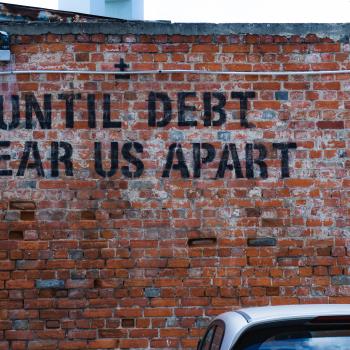This guest post was written by Mike Young who writes about improving lives one marriage at a time at his blog. If you’re interested in writing a guest post for Faith and Finance, let us know.
When debt overwhelms our life, it often happens slowly. I have yet to meet anyone who planned to rack up a pile of debt. It happens a little here and a little there over time. You may even find yourself in a situation where you cannot make all of your minimum debt payments. How are you supposed to handle that? If you are Christian, I know you want to do the right thing and pay back your debts. It’s not something you did on purpose. There is a way to handle it and keep your morals in tact.
1) Understand that you cannot create money out of thin air.
Often, people who find themselves in this situation feel guilty about not being able to pay. Honestly, there should be some guilt there, but you cannot let it paralyze you. Instead, you have to use it to motivate you. Do the right thing by creating a plan of action.
2) Take care of your necessities first.
You have to make sure that the basics of life are covered before you ever make a payment to Visa. I’m not saying you won’t ever pay them. But if you have to choose between eating and paying American Express, eating it is! Make sure that food, utilities, shelter, reasonable transportation, reasonable clothing, and insurances are taken care of first. If those are the only things you can afford right now, you can at least live to fight another day.
3) Figure out how much money you have left after necessities.
Chances are, even if you don’t have enough to cover all of your minimum debt payments, you will have some money to pay debts with. For example, let’s say your income is $3,500 per month. If your necessities add up to $3,100, you are left with $400 to pay on debts.
4) Make a list of all of your debts from smallest balance to largest balance.
In other words, let’s say you owe $100 to Visa, $600 to Mastercard, a $2,000 personal loan, $2,500 to American Express, $3,500 to Home Depot Finance and $6,000 for a unsecured bank loan. You would list them in that order, from $100 to $2,000. Add up the total amount of debt. So, the total in this example would be $14,700.
5)Determine the percentage each debt is of your overall debt.
I know this is a little hard to write out in words, but bear with me here. It will be easier to follow using our example again. The $100 Visa is .7% of the $14,700 total debt. The $6,000 unsecured bank loan would be 40.8% of the total debt. Do the same math for all of the debts.
6) Take each percentage times your amount to pay on debts.
To continue with our example, take $400 (from # 3 above) times .7% for Visa, 4.1% for Mastercard and so on. That gives the following amounts: $3 for Visa, $16 for Mastercard, $54 for the personal loan, $68 for American Express, $95 for Home Depot, and $163 for the unsecured bank loan. Now you have an amount to pay each debtor .
7) Send each creditor the amount you calculate in step #6
In most cases, this will not be enough to cover the minimum payment. I can tell you right now that this will not make your creditors happy. They will scream and wail, but remember, it is all you can do (see #1 above!). Most creditors will not pursue any kind of legal action if you are sending them something. To be clear, they CAN pursue legal action if you are not holding up your end of the deal (like making the minimum payment), but they are highly unlikely to do so. That is especially true if you stay in contact with them and let them know your process in determining how much you are sending them. Again, they will not like it, but I am sure they will cash the check!
8) Determine a long term solution.
Obviously, this plan is not going to reduce your debt. It is only meant to buy time while you put a longer term plan in motion. The first thing to do is to start living on a budget so that you can find more money to put towards debt. Also, you are most likely going to have to get a second or third job. This is only a temporary thing, but it will accelerate the amount of time it takes to become debt free. You also might have to sell some things. It could be a vehicle whose payments are too high. It might, in extreme cases, mean you have to sell your house. I only recommend this if your house payment is over 35% of your take home pay or you have enough equity built up that you could sell your house and pay off all of your debts. The point is that you have to get radical in order to have a long-term solution to pay the debts you owe.
I realize there are other ways to handle paying off or erasing debts. I just truly believe this is the best way. It is an honest way to handle not having enough money to pay your bills. The important thing is to not give up, not become paralyzed with fear, and move into action.
How have you handled times where you didn’t have enough money to pay your monthly bills?











